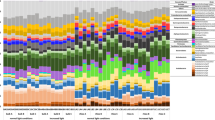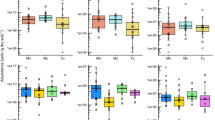Abstract
Well-drained non-agricultural soils mediate the oxidation of methane directly from the atmosphere, contributing 5 to 10% towards the global methane sink1,2. Studies of methane oxidation kinetics in soil infer the activity of two methanotrophic populations: one that is only active at high methane concentrations (low affinity) and another that tolerates atmospheric levels of methane (high affinity). The activity of the latter has not been demonstrated by cultured laboratory strains of methanotrophs, leaving the microbiology of methane oxidation at atmospheric concentrations unclear3,4. Here we describe a new pulse-chase experiment using long-term enrichment with 12CH4 followed by short-term exposure to 13CH4 to isotopically label methanotrophs in a soil from a temperate forest. Analysis of labelled phospholipid fatty acids (PLFAs) provided unambiguous evidence of methane assimilation at true atmospheric concentrations (1.8–3.6 p.p.m.v.). High proportions of 13C-labelled C18 fatty acids and the co-occurrence of a labelled, branched C17 fatty acid indicated that a new methanotroph, similar at the PLFA level to known type II methanotrophs, was the predominant soil micro-organism responsible for atmospheric methane oxidation.
This is a preview of subscription content, access via your institution
Access options
Subscribe to this journal
Receive 51 print issues and online access
$199.00 per year
only $3.90 per issue
Buy this article
- Purchase on Springer Link
- Instant access to full article PDF
Prices may be subject to local taxes which are calculated during checkout



Similar content being viewed by others
References
Cicerone, R. J. & Oremland, R. S. Biogeochemical aspects of atmospheric methane. Glob. Biogeochem. Cycles 2, 299–327 (1988).
Crutzen, P. J. Methane's sinks and sources. Nature 350, 380–381 (1991).
Hanson, R. S. & Hanson, T. E. Methanotrophic bacteria. Microbiol. Rev. 60, 439–471 (1996).
Conrad, R. Soil microorganisms as controllers of atmospheric trace gases (H2, CO, CH4, OCS, N2O, and NO). Microbiol. Rev. 60, 609–643 (1996).
Boschker, H. T. S. et al. Direct linking of microbial populations to specific biogeochemical processes by 13C-labelling of biomarkers. Nature 392, 801–804 (1998).
Hinrichs, K-U., Hayes, J. M., Sylva, S. P., Brewer, P. G. & Delong, E. F. Methane-consuming archaebacteria in marine sediments. Nature 398, 802–805 (1999).
Zelles, L. & Bai, Q. Y., Rackwitz, R., Chadwick, & Beese, F. Determination of phospholipid and lipopolysaccharide-derived fatty acids as an estimate of microbial biomass and community structures in soils. Biol. Fertil. Soils 19, 115–123 (1995).
Bowman, J. P., Skerratt, J. H., Nichols, P. D. & Sly, L. I. Phospholipid fatty acid and liposaccharide fatty acid signature lipids in methane utilizing bacteria. FEMS Microbiol. Ecol. 85, 15–22 (1991).
Nichols, P. D., Smith, G. A., Antworth, C. P., Hanson, R. S. & White, D. C. Phospholipid and lipopolysaccharide normal and hydroxy fatty acids as potential signatures for methane-oxidizing bacteria. FEMS Microbiol. Ecol. 31, 327–335 (1985).
Dunfield, P. F., Werner, L., Henckel, T., Knowles, R. & Conrad, R. High affinity methane oxidation by a soil enrichment culture containing a type II methanotroph. Appl. Environ. Microbiol. 65, 1009–1014 (1999).
Nichols, P. D. et al. Detection of a microbial consortium, including type II methanotrophs, by use of phospholipid fatty acids in an aerobic halogenated hydrocarbon-degrading soil column enriched with natural gas. Environ. Toxicol. Chem 6, 89–97 (1987).
Guckert, J. B., Ringelberg, D. B., White, D. C., Hanson, R. S. & Bratina, B. J. Membrane fatty acids as phenotypic markers in the polyphasic taxonomy of methylotrophs within the Proteobacteria. J. Gen. Microbiol. 137, 2631–2641 (1991).
Bender, M. & Conrad, R. Effect of CH4 concentrations and soil conditions on the induction of CH4 oxidation activity. Soil Biol. Biochem. 27, 1517–1527 (1995).
Roslev, P. & Iversen, N. Radioactive fingerprinting of microorganisms that oxidize atmospheric methane in different soils. Appl. Environ. Microbiol. 65, 4064–4070 (1999).
Hall, G. H., Simon, B. M. & Pickup, R. W. CH4 production in blanket bog peat: a procedure for sampling, sectioning and incubating samples whilst maintaining anaerobic conditions. Soil Biol. Biochem. 28, 9–15 (1996).
Bligh, E. G. & Dyer, W. J. A rapid method of total lipid extraction and purification. Can. J. Biochem. Physiol. 37, 911–917 (1959).
Guckert, J. B., Antworth, C. P., Nichols, P. D. & White, D. C. Phospholipid, ester-linked fatty-acid profiles as reproducible assays for changes in prokaryotic community structure of estuarine sediments. FEMS Microbiol. Ecol. 31, 147–158 (1985).
Jones, D. M., Carter, J. F., Eglinton, G., Jumeau, E. J. & Fenwick, C. S. Determination of δ13C values of straight chain and cyclic alcohols by gas chromatography isotope ratio mass spectrometry. Biol. Mass Spectrom. 20, 641–646 (1991).
Rieley, G. Derivatization of organic compounds prior to gas chromatographic-combustion-isotope ratio mass spectrometric analysis: Identification of isotope fractionation processes. Analyst 119, 915–919 (1994).
Acknowledgements
We thank J. Carter and A. Gledhill for their help with GC/MS and GCC/IRMS analyses and C. Davies for setting up the long-term enrichment experiment. This study was supported by the Natural Environment Research Council through the CEH Integrated Fund (N.R.P., P.I., G.H.H.) and through a Non-thematic Research Grant (P.I. and R.P.E.).
Author information
Authors and Affiliations
Corresponding author
Rights and permissions
About this article
Cite this article
Bull, I., Parekh, N., Hall, G. et al. Detection and classification of atmospheric methane oxidizing bacteria in soil. Nature 405, 175–178 (2000). https://doi.org/10.1038/35012061
Received:
Accepted:
Issue Date:
DOI: https://doi.org/10.1038/35012061
This article is cited by
-
Tracing carbon and nitrogen microbial assimilation in suspended particles in freshwaters
Biogeochemistry (2023)
-
Microbial oxidation of atmospheric trace gases
Nature Reviews Microbiology (2022)
-
Rainforest-to-pasture conversion stimulates soil methanogenesis across the Brazilian Amazon
The ISME Journal (2021)
-
The Variation of Microbial (Methanotroph) Communities in Marine Sediments Due to Aerobic Oxidation of Hydrocarbons
Journal of Ocean University of China (2021)
-
Methane oxidation in lead-contaminated mineral soils under different moisture levels
Environmental Science and Pollution Research (2017)
Comments
By submitting a comment you agree to abide by our Terms and Community Guidelines. If you find something abusive or that does not comply with our terms or guidelines please flag it as inappropriate.



